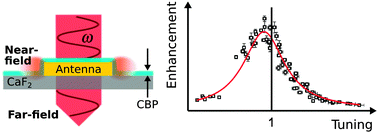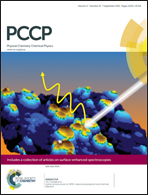Impact of the plasmonic near- and far-field resonance-energy shift on the enhancement of infrared vibrational signals†
Abstract
We report on the impact of the differing spectral near- and far-field properties of resonantly excited gold nanoantennas on the vibrational signal enhancement in surface-enhanced infrared absorption (SEIRA). The knowledge on both spectral characteristics is of considerable importance for the optimization of plasmonic nanostructures for surface-enhanced spectroscopy techniques. From infrared micro-spectroscopic measurements, we simultaneously obtain spectral information on the plasmonic far-field response and, via SEIRA spectroscopy of a test molecule, on the near-field enhancement. The molecular test layer of 4,4′-bis(N-carbazolyl)-1,1′-biphenyl (CBP) was deposited on the surface of gold nanoantennas with different lengths and thus different far-field resonance energies. We carefully studied the Fano-type vibrational lines in a broad spectral window, in particular, how the various vibrational signals are enhanced in relation to the ratio of the far-field plasmonic resonance and the molecular vibrational frequencies. As a detailed experimental proof of former simulation studies, we show the clearly red-shifted maximum SEIRA enhancement compared to the far-field resonance.

- This article is part of the themed collection: Surface-enhanced spectroscopies

 Please wait while we load your content...
Please wait while we load your content...